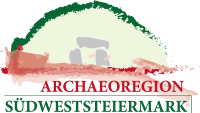In historical museum architecture, the display collection with modern media allows a look behind the scenes of Styrian fire departments. Highlights are the extensive helmet collection and the vehicle halls with the popular vintage cars. Fire and art unite in an “explosive mixture” throughout the entire season. Varying art and cultural exhibitions allow a foray through Styrian cultural events as well as through the history of foreign cultures. With a diversified supporting program throughout the season, the museum has also established itself as an art and culture platform.
The Styrian Fire Brigade Museum Art and Culture dedicates a small but fine exhibition to the archaeological excavation activities in the quarter of Grünau in Gross St. Florian. Contributions about excavation history as well as finds from neighboring settlements of Grünau frame the sensational find of the “silver cup of Grünau” which is in the center of the exhibition. The exhibition is accompanied by a catalog.
Mid-March to end of October
Tues. – Sun., 10 a.m. – 5 p.m. (Last admission 4.30 p.m.)
November to April closed
Contact:
Marktstraße 1, A-8522 Groß St. Florian
T: +43 3464 8820, office@feuerwehrmuseum.at
www.feuerwehrmuseum.at
Roman Villa Grünau
The beginnings of archaeological research in Gross St. Florian date back to Karl Haas in 1855 and are documented by a drawing of the mosaic floor of the villa of Grünau. After its rediscovery in the late 1980s, excavations of the villa were carried out in several project phases from 1988 to 2002 by Karl Franzens University in Graz, managed by Erwin Pochmarski. These excavations discovered that the villa was systematically enlarged in six different construction phases.
Findings
In Roman times, the Lassnitz River Valley was served by a solid gravel road 26 km long, which crossed the valley in a dead straight line for long stretches. Village settlements and manors were located in the areas of Lassenberg, Wettmannstätten, Hörbing and Deutschlandsberg. Finds were also discovered in the neighboring settlements of Grünau, such as Grub, Petzelsdorf, Krottendorf, Lebing and Zeierling. Terra Sigillata holds important clues to the economic history in the Lassnitz River Valley and to datings. The decorations and the names of the potters provide information about the time of origin, ranging from 90 to 180 A.D. Storage vessels as well as weaving weights and spindle whorls indicate arable farming and wool processing, and the cattle bell is evidence of pasture farming. The main farm animals were cattle, pigs, sheep, goats, horses, dogs, cats, and various types of poultry.
The Roman stone
Originally, the stone was part of a tomb of a duumvir or sevir who had his residence in the villa in Grünau. In the Middle Ages it was reworked into the tombstone of a priest who was buried in the church in Gross St. Florian. In the 19th century it was removed in the course of a reconstruction and used in the material backfill for the churchyard wall. There it was rediscovered in 1951 and installed at the front of this wall. Since 1995 it has been kept here in the museum.
The silver skyphos
The silver skyphos, dating from the 1st century A.D., was discovered in 1990 during excavations by the Institute of Archaeology of the Karl Franzens University in the Roman villa of Grünau near Gross St. Florian. When it was found, the so-called “silver cup of Grünau” was complete, but disassembled into its individual parts – inner and outer cup, handle and base. However, these could be put together during the restoration. Today, the original is displayed in the Archaeology Museum of the Joanneum Universal Museum in Eggenberg Palace.
Text: Anja-Weisi Michelitsch

